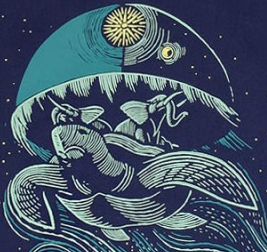
Bumble dragons are small cousins of the grander wyrm. While incredibly clever, the general consensus is that they're non-sapient.
Bumble dragons are increasingly popular as pets in the high societies of Veshiri and with the bohemian artists. Their popularity has started to spread to other planets, some, leading to attempts to catch more bumble dragons in the wild. However, wild-caught bumble dragons are often ill-tempered and poorly suited to the home, unlike the friendly domesticated bumble, and very little success has been had with taming them. Domestic bumble dragons reproduce only slowly, and not at nearly high enough levels to satisfy demand.
They were domesticated an unknown number of years ago, though they have been recorded in art and writing for at least ten thousand years. Theories vary as to why they were initially domesticated - the larger breeds can certainly help keep down vermin, and they sometimes serve as watch-animals due to their cleverness, keen senses, and loud vocalizations - but the predominant theory is that they were simply considered an exotic pet for nobles. However, there's a competing theory that posits the bumble dragons essentially domesticated themselves soon after elves first entered their native rain forests, identifying people as a ready source of food and shelter, and helping the newcomers keep watch for dangerous predators in return.
Bumble dragons fetch a variety of prices, depending on their size and morph - smaller dragons go for more, as do rarer morphs.
Bumbles have multiple subspecies or breeds, which primarily determine their size and ornamentation (horns, frills, and spikes).
Bumble dragons lay one or two eggs at a time, with eggs ranging from the size of a coffee bean to as large as a chicken egg. Their breeding season is in the early spring in temperate regions and the start of the wet season in tropical regions. They form nests for their young, with materials depending on the size of the nest.
Bumble dragons prefer it warm, being naturally found throughout the tropics of the world. They're prone to illness when exposed to low temperatures for too long, and will rapidly sicken if in a freezing clime. They are not recommended for pet owners far to the north or south, or in ice worlds, though those in temperate areas can keep their pet healthy through the winter with a heat-stone or basking lamp. In addition, outside of the more humid climes, it is recommended to provide them with an extensive amount of water for soaking in, for optimal scale health.
They like cramped areas, and plenty of things to climb upon - the greater the resemblance to their native rain forests, the better. Bumble dragons show signs of stress in wide-open regions, and like having somewhere dark and moist to hide at times.
Bumble dragons eat a mixture of fruit and meat. They often appreciate liquid sweets like honey or cream as treats. They cannot digest nuts or woody plants.
Young bumble dragons shed very frequently, replacing the top layer of their scales as often as once a month. When young (and sometimes even as they age), they frequently need a shed box, a moist enclosure containing moss and pieces of bark for them to rub themselves on to help the loosening shed slough off.
Bumble dragons are social creatures, often sleeping cuddled up in the wild, and frequently physically affectionate with their owners when domesticated.
Domesticated bumble dragons have larger eyes and softer features than many wild bumble dragons, but are still technically the same species. Domesticated varieties often also have more complex patterns, though the same vividness of color is found in all bumble dragons.
The species' native range consists of the low-elevation tropics of the planet Veshiri in a band around the equator. Sapient desire for them as pets has since expanded their range.
The true intelligence of bumble dragons is debated. They can certainly be trained, and often perform in circuses, and owners have reported them engaging in what seems to be efforts at art if supplied with paint. They have a chittering way of talking among themselves, that varies with region, but does not seem to have all the features of a true language. The smartest recorded bumble dragon has been taught to recognize over one thousand items, and a few have been reported observing and mimicking aspects of sapient behavior.
Bumble dragons have a wide visual range, able to see not only the human visual spectrum of color, but also ultraviolet and infrared light, and they can perceive more gradients of color than humans thanks to extra cones in their eyes. Most bumbles have five types of cones, including one sensitive to ultraviolet light and one sensitive to different parts of the standard visual spectrum. They also generally have pits at the end of their nose designed to sense infrared light.
Lifespan
Bumble dragons live 60 years on average, though smaller breeds live longer than larger breeds
Average Height
1-10 inches, depending on breed
Average Weight
0.069 ounces to 11 pounds
Average Length
2.5 inches to 24 inches in total length, including the tail
Body Tint, Colouring and Marking
Bumble dragons come in a wide variety of different patterns, known as morphs. Most have jewel-toned scales with deep, rich colors. Stripes and spots are not uncommon patterns. Morphs exist across breeds, so a corn bee bumble is a dragon of the tiniest breed, with a pattern of yellow, orange, red, and dark brown scales. The rarest and most expensive morph is the Ivory morph, a pure white morph with little discernible pattern, with one fine specimen selling for 3,000 Veshiri crowns. The next is the Rainbow morph, a shimmering iridescent morph noted for how rarely it breeds true.
Comments
Please Login in order to comment!









Is the bumble-dragons' size tied to particular regions or subspecies, or are they all of varying size relative to eachother? They sound neat. Is there a reason to domesticate them or is it purely vanity?
Check out my summercamp by going here and checking out any of my gold-star articles!
It's tied to subspecies, yeah. Larger breeds can be used to keep down vermin, and they can act as effective watch animals because of how noisy they can get, but the main reason for domestication seems to have been purely as a showy pet (although there's some theories a few might've essentially domesticated themselves, identifying people as ready sources of food)
Oooh, in that latter case you might research into canine co-evolution with humans. There's a theory that canines affected human evolution and made us more social.
Check out my summercamp by going here and checking out any of my gold-star articles!
Cool! I think they might've affected early settlers in rain forest areas, since their purpose as watch-animals would've been a lot more present there. they definitely helped with avoiding predators, they alarm *loud*, but 'these critters moved in with us, stole our food, and started screaming when they saw a wildcat' is not usually recorded in written history :P